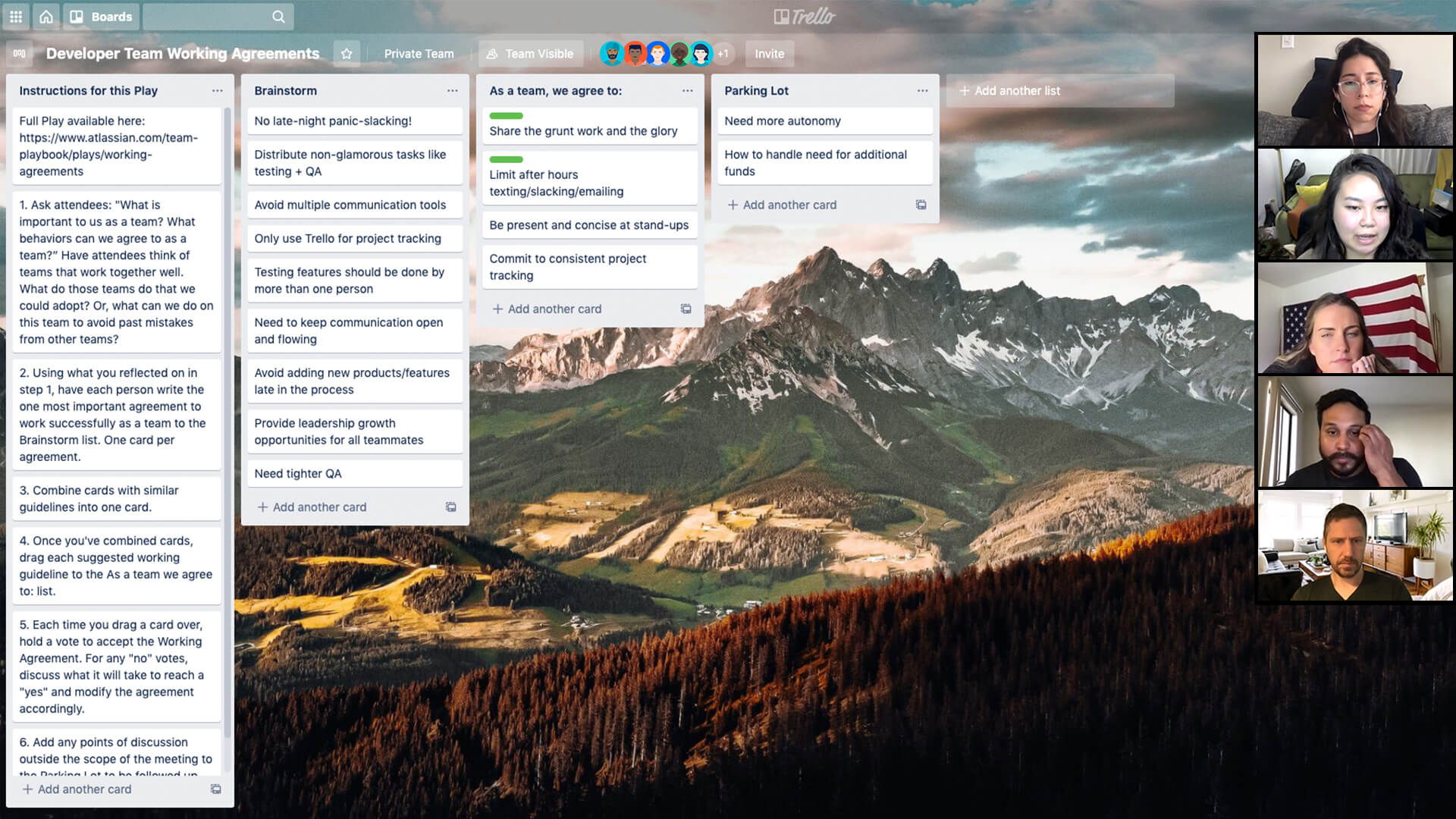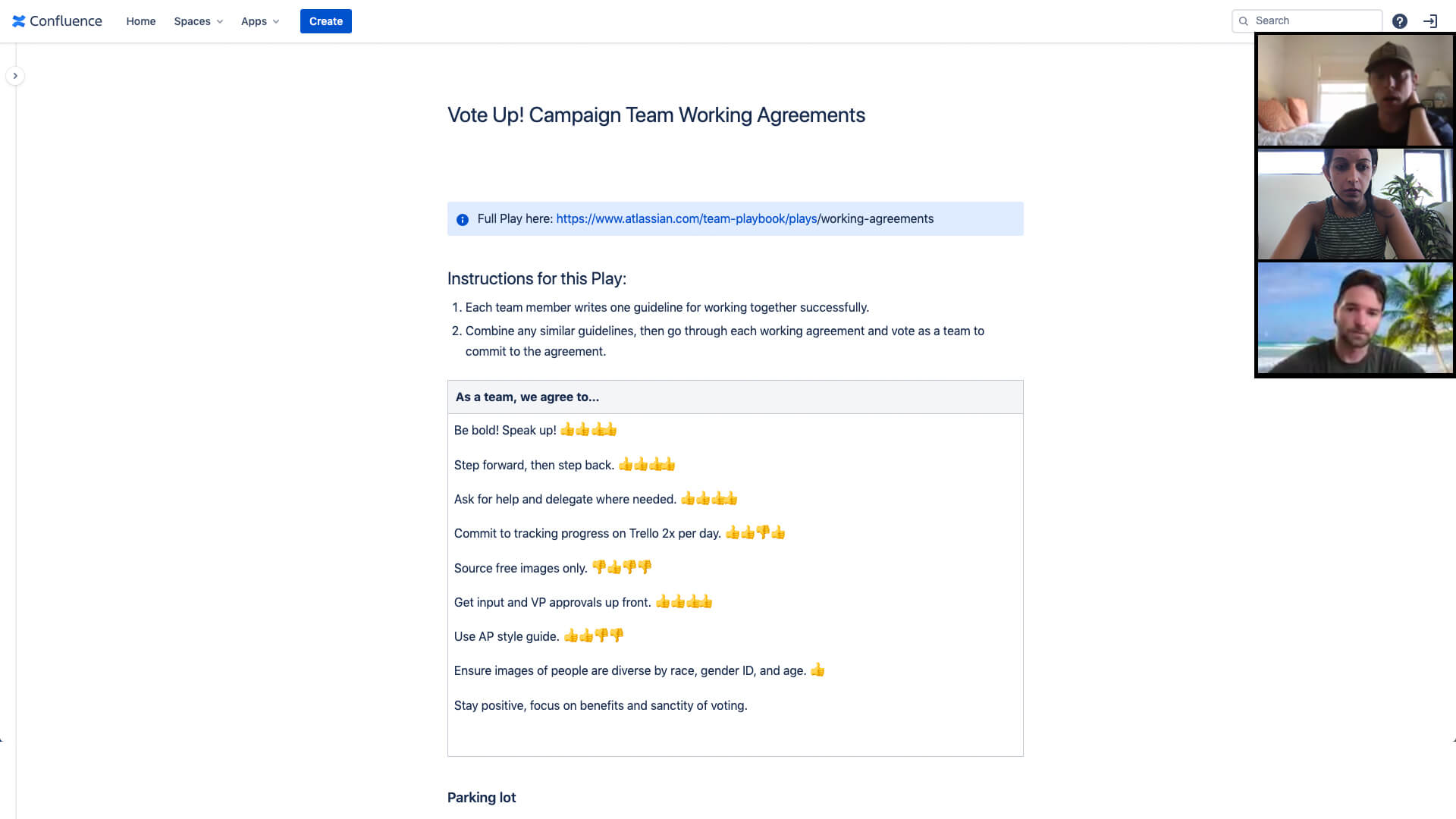Working Agreements
Everyone has different working styles, but reaching your goals requires working together. Outline your team’s shared ways of working so you can set mutual expectations, save time, and collaborate effectively.

PREP TIME
10 min
Run TIME
60m
Persons
2-10
5-second summary
- Understand when and how your teammates work best.
- Set mutual expectations for team communication.
- Determine the most efficient, effective ways to work together.
WHAT YOU WILL NEED
- Video conferencing with screen sharing.
- Digital collaboration tool (see template examples).
- Optional: physical whiteboard, markers, and sticky notes.
PLAY resources
How to create team working agreements
Create shared norms that help your team work well together to achieve common goals.
What is a working agreement?
Working agreements are shared norms for how a team will work together, communicate, and collaborate, whether they’re in the same location or across multiple time zones.
Why create working agreements?
Each person has their own practices, but achieving goals as a team requires adopting ways of working that work for everyone. Even when things seem to be going smoothly, there is always room for improvement.
Atlassian’s Teamwork Lab tested this Play at Atlassian and found:
- 74% of employees who ran this Play felt empowered to speak up about changes they’d like to see within their team to work better together.
- Working agreements helped teams create stronger buy-in from every team member, share ownership of decisions, and develop long-term solutions to problems with ways of working.
When should you run a Working Agreements Play?
Whether your team is new or well-established, there’s never a “bad” time to create working agreements. This Play is especially helpful when onboarding new team members, after a re-org, or when work scenarios change.
The benefits of working agreements
Research from Atlassian’s Teamwork Lab and academic literature suggests working agreements help:
- Run fewer, more purposeful meetings (and know when to make them async).
- Communicate clearly.
- Reduce misunderstandings.
- Enhance communication
- Increase team performance
- Improve conflict resolution
- Increase psychological safety
- Accelerate onboarding
1. Facilitator prep
Est. time: 5 MIN
- Send a message to the team explaining the Play to ensure everyone understands the topic and goal of the meeting: to create a set of behavioral agreements that will guide how to work together.
- Create a collaborative document, such as a Trello board, whiteboard, or a Confluence page.
- Send the document to the team at least a few days ahead of the Play with instructions on what to do. (See “Team member prep” and “Leader prep” below.) Provide context around working agreements and the importance they play in setting up a team for success. If you’ve created a Team Poster, include that in your message to remind everyone of the team’s purpose and objectives.
- Collect issues the team is currently facing, either from a Retrospective or previous experiences and feedback. These challenges will inform the Play.
TIP: CREATE YOUR USER MANUAL
A great way to help new team members, contractors, project teams, stakeholders, and network teams onboard with your team quickly is to complete a User Manual that explains how you like to work.
2. Team member prep
Est. time: 5 MIN
Ask each person to fill out the template with one or two thoughts about each of the following topics. (People can also link to their User Manual to explain more about how they work best.)
- Name
- Working location and time zone
- Working hours and commitments
- Working environment and preferences
- How I like receiving feedback
- Context about me
3. Leader prep
Est. time: 10 min
Before the live Play workshop, fill out a draft of the following two sections in the template.
Communication channels
Consider how your team is going to effectively communicate. Fill in the channel, its purpose, the audience, and any standards set for communication in that space. For example, you may use Confluence as the single source of truth for documentation and planning, along with Slack for daily communication.
Escalation process
As the saying goes, a failure to plan is a plan to fail. Consider how you want your team to escalate pressing issues or make decisions when they can’t reach a consensus. Fill in who the decider is, how you will handle escalations, what level of transparency you will provide, and how you will inform others of decisions.
Not sure how to handle escalations? Try our DACI decision-making framework. You can also work with your team to provide a Clean Escalations pathway that will outline options for escalation and guide better decision-making.
4. Start the Play by setting the stage
Est. time: 15 min
Open the workshop by recapping the purpose of the meeting and setting some mutual agreements for the workshop, such as asking the team to:
- Keep an open, curious mind
- Practice active listening and encourage everyone to contribute
- Minimize distractions and maximize connection: phones away, cameras on, ‘Do not disturb’ on
- Try not to interrupt others, and give everyone an opportunity to speak
- Remember that the working agreements will be adjusted over time
Next, provide a summary of the current team challenges gathered before the workshop. These challenges help spark ideas for how to improve ways of working.
Then, give the team five minutes to silently read through the draft document that everyone contributed to as pre-work. Team members can comment on the page too.
Finally, ask each person to share one new thing they learned about another team member. This will help everyone get to know each other better and warm up the conversation.
TIP: PEOPLE, NOT PROCESS
This Play is about working together as people. If ideas around process come up, create a “Parking Lot,” and set up a separate time to talk about those topics so you can keep the group focused.
5. Edit Communication Channels
Est. time: 10 min
Take ten minutes to discuss and edit the Communication Channels section as a team. You can make edits to the digital document and/or write ideas on a physical whiteboard if you’re meeting in person. (Just make sure to document digital notes from the physical whiteboard for future reference.)
Conversation starters:
- Any additions, removals, or changes?
- When should we review if this is working?
- How do we want other teams, leaders, or stakeholders to communicate with us?
TIP: REACH COMPROMISE, NOT CONSENSUS
Having trouble agreeing on the best way to achieve results as a team? It’s very common for team members to have different preferences. One person may prefer to use Slack, while another prefers a Zoom call. Use voting to arrive at a comfortable compromise to try as a team, with the promise that this is a starting point to test and adjust over time.
6. Create or refine your meeting plan
Est. time: 30 min
Collaboration is essential to hitting your team’s goals, but it doesn’t always require a meeting. During this part of the workshop, you’ll discuss as a team why, when, and how to use synchronous meetings and asynchronous communication, such as sending written updates with a tool like Slack, video updates with a tool like Loom, or brainstorming with a tool like Confluence whiteboards.
(Trying to decide whether synchronous or asynchronous communication makes more sense? See the difference between sync vs. async so you can choose which medium is best for each situation.)
As you narrow down the cases when a meeting is needed, talk through these questions with your team to audit existing meetings and thoughtfully plan for the future:
- What types of meetings are needed?
- What meeting format will help accomplish our goals? (Page-led meetings are especially effective.)
- What cadence and length are appropriate?
- Who should attend, and what are their roles in the meeting?
-
Which of these meetings will we allow an AI notetaker to attend by default?
When async communication is a good alternative, talk through these questions with your team:
- What types of async communication will help us accomplish our goals? (e.g., written messages, videos, whiteboarding, etc.)
- Who should be involved, and what are their roles? (e.g., Who’s creating content, and by when? Who’s contributing, and by when? Who’s reviewing, and by when)?
-
What should the cadence be?
Figuring out the right balance between sync and async communication may take some experimentation. Finish this part of the conversation by discussing: When should we review if this is working?
TIP: TIMEZONE WRANGLING
Have a distributed team working across multiple time zones? It can help to map out collaboration windows to create a shared understanding of the hours that best suit synchronous activities.
7. Edit the Escalation Process
Est. time: 10 min
Review and edit the Escalation Process section that your leader started. Discuss as a team any additions or changes that need to be made until the team comes to a consensus.
8. Establish a Continuous Improvement Plan
Est. time: 10 min
The working agreements set during this workshop are simply a starting point that can – and should – be updated over time. As the final step of the workshop, discuss how you will adjust these agreements as the team learns and grows.
Conversation starters:
- When should we revisit these working agreements, and why? (e.g., quarterly based on lessons learned, after a big milestone, etc.)
- How will we decide if an agreement needs to be adjusted?
- What level of transparency is required and/or “nice to have”?
- How will we share any changes?
Follow-up
Revisit regularly
Beyond quarterly working agreement reviews, it’s also helpful to revisit when onboarding new team members, during team reorgs, when work scenarios change, or when an agreement can no longer be upheld. This is especially important if your team transitions to hybrid or fully distributed work. Your rituals and agreements will have to change to accommodate different geographies, time zones, and technology.
Go through and vote to keep or change existing agreements. Then have team members brainstorm, propose, and vote on any additional agreements.
If an agreement can’t be upheld, discuss what might be getting in the way.
Revisit regularly
Beyond quarterly working agreement reviews, it’s also helpful to revisit when onboarding new team members, during team reorgs, when work scenarios change, or when an agreement can no longer be upheld. This is especially important if your team transitions to hybrid or fully distributed work. Your rituals and agreements will have to change to accommodate different geographies, time zones, and technology.
Go through and vote to keep or change existing agreements. Then have team members brainstorm, propose, and vote on any additional agreements.
If an agreement can’t be upheld, discuss what might be getting in the way.
Variations
Test your working agreements with a set of reflections:
- Think of teams that work together well. What do those teams do that we could adopt?
- What can we do on this team to avoid past mistakes from other teams?

Still have questions?
Start a conversation with other Atlassian Team Playbook users, get support, or provide feedback.
Other plays you may like
Collaboration
Roles and Responsibilities
Clarify individual responsibilities and find gaps that need to be filled.
Project planning
Network of Teams
Map out and optimize cross-team relationships at the beginning of a project.
PROJECT PLANNING
Project Kick-Off
Build consensus on objectives, timing, scope, and decision-making.
Debriefs
5 Whys Analysis
Uncover the root of a problem and explore possible solutions.
Stay up to date
Get the latest Plays and work life advice when you sign up for our newsletter.

















